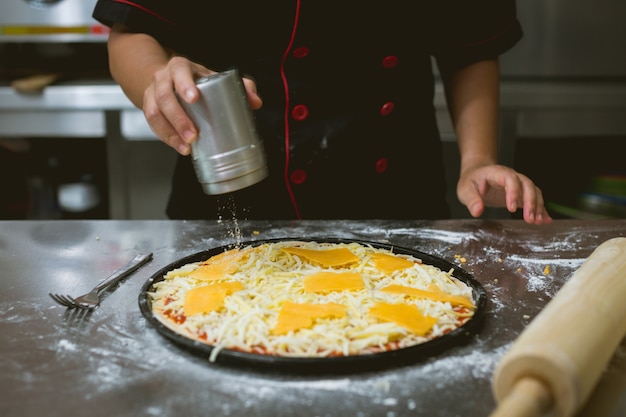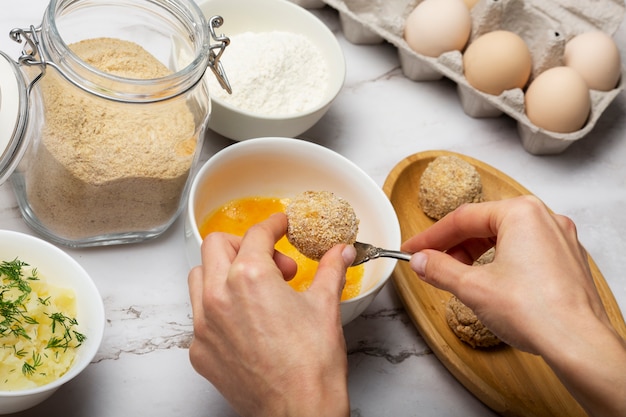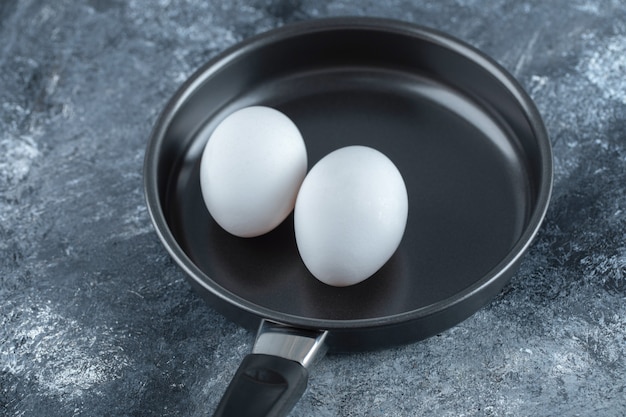We've all been there - staring at a pot of boiling water, wondering if our hard-boiled eggs will be a culinary triumph or a rubbery disaster. For years, I struggled with inconsistent results, often ending up with eggs that were either too runny or too hard. But after countless trials and errors, I finally discovered the secrets to achieving those perfectly cooked, deliciously firm hard-boiled eggs. Let me share my journey with you, and you'll never have to fear another egg-boiling mishap again.
Part 1: Setting the Stage - The Foundation of a Flawless Egg

The perfect hard-boiled egg journey begins with a little preparation. It's like getting your ingredients ready for a delicious cake – you need the right foundation to build on.
The Egg-cellent Choice
choosing the right eggs is like picking the perfect flour for your cake – it sets the tone for the whole experience. While you don't need to break the bank on organic free-range eggs, I find that they offer a richer flavour and a more vibrant yellow yolk. It's all about those little details that elevate the experience, you know? Also, older eggs with a firmer white result in a smoother texture. You see, the white of an egg actually becomes more firm as it ages, which leads to a better peeling experience and a less rubbery texture. So, if you want to avoid those pesky rubbery whites, grab some eggs that have been sitting in your fridge for a while. Trust me, it makes a difference!
The Kitchen Arsenal – What You'll Need
You don't need a fancy gadget to create culinary magic. All you need are a trusty saucepan and a slotted spoon. But hey, if you're a gadget enthusiast like me, you might enjoy using an egg timer. It's a real lifesaver if you're multitasking in the kitchen. And an egg piercer? I used to think it was a must-have, but honestly, it's not essential. Just a tiny hole in the egg to help prevent cracking. But, if you're feeling anxious about cracks, go for it. And lastly, don't forget the big bowl of ice water – we'll get to that later.
Part 2: The Boiling Process – Where the Magic Happens

Now, you've got your eggs and your tools. Get ready for the exciting part, the boiling process! It's not as simple as just throwing your eggs into boiling water. There's a bit of an art to it, a rhythm that leads to perfection.
The Gentle Start
First, fill your saucepan with cold water, enough to cover the eggs by about an inch. Now, here's where the magic begins. Don't rush into boiling the water. Instead, gently heat it over medium heat. Imagine you're coaxing the eggs into a gentle, comfortable temperature. This slow and steady approach helps to prevent the eggs from cracking during the boiling process. Think of it like a warm bath for your eggs, no sudden surprises. And you know how much we hate those cracked eggs, right?
The Boiling Point
Once the water reaches a simmer, gently add the eggs to the pan. The simmering water will gradually bring the eggs to temperature without shocking them. Now comes the crucial part - timing! The time you let your eggs simmer determines how hard-boiled they will be. And we're aiming for that perfect balance, remember?
Part 3: Decoding the Boiling Times – Finding Your Perfect Egg

It's all about finding the right balance. Do you prefer a runny yolk, a slightly firm yolk, or a completely hard-boiled experience? This is where the magic of timing comes in. I've created a handy table for you to find your perfect egg.
| Egg Type | Boiling Time |
|---|---|
| Soft-Boiled | 3-4 minutes |
| Medium-Boiled | 6-7 minutes |
| Hard-Boiled | 8-10 minutes |
soft-boiled eggs
These are for the adventurous souls who crave a runny yolk with a slightly firm white. Think of it as a luxurious breakfast treat. I love dipping them in a bit of salt and pepper, or even a dollop of butter for a truly decadent experience.
medium-boiled eggs
The sweet spot for many. The yolk is still slightly runny, but the white is firm. Perfect for those who want a touch of creaminess but also a good bite. Great for salads, sandwiches, or just a quick snack. A truly versatile egg!
Hard-Boiled Eggs
These are for those who prefer a firm, consistent texture. Ideal for deviled eggs, egg salad, or even just a plain snack. But be careful not to overcook them! We'll delve into that a bit later. Overcooked eggs can lead to a rubbery texture, and we don't want that, do we?
Part 4: Cooling Down – The Quick Chill
Once your eggs have finished simmering, it's time to give them a quick shock! Remember that bowl of ice water? Gently transfer the eggs from the saucepan to the ice bath. This sudden change in temperature stops the cooking process and prevents the yolk from turning green. That's right, a green yolk is a sign of overcooked eggs, and we definitely want to avoid that. It's not only unsightly, but it can also indicate that the egg is dry and rubbery.
Let the eggs chill in the ice bath for at least 5 minutes. This also makes the shells easier to peel. Speaking of peeling, let's tackle that next.
Part 5: Peeling Time – The Art of the Shell
You've come this far. The anticipation is high. But peeling hard-boiled eggs can be a bit of a delicate dance. I've tried countless techniques, but I've found that simplicity often leads to the best results.
Step 1: The Gentle Tap
Gently tap the top and bottom of the egg on a hard surface. This creates a few cracks in the shell, making it easier to peel. The key is to create cracks, not to smash the egg!
Step 2: The Rolling Technique
Now, for the fun part. Roll the egg between your hands, applying a bit of pressure. This helps to loosen the shell further, making it even easier to peel. Remember, be gentle, you don't want to end up with a broken egg.
Step 3: The Peel
Finally, it's time to peel! Start at one end of the egg and carefully work your way down. If you encounter any stubborn bits, use a small spoon or knife to gently pry them off. But be careful not to damage the delicate egg beneath.
And there you have it, your perfectly peeled, hard-boiled egg. A triumph of patience and precision! Feel proud of yourself, you've earned it!
Part 6: The Art of Storage – Keeping Your Eggs Fresh
Now that you have those pristine hard-boiled eggs, it's crucial to store them properly. You want them to stay fresh and delicious, ready for your next culinary adventure.
I prefer to store my hard-boiled eggs in an airtight container in the refrigerator. I like to keep them in a single layer, so they don't get squashed. And I always add a damp paper towel to the container. This helps to keep the eggs moist and prevents them from drying out. This simple trick helps keep them fresh for up to a week, ready to be enjoyed whenever you need them.
Part 7: The Culinary Adventures – Cooking with Hard-Boiled Eggs
Alright, so you've mastered the art of the hard-boiled egg. What's next? The world of culinary possibilities is your oyster! Hard-boiled eggs can be the star ingredient in countless delicious dishes.
classic deviled eggs
A timeless classic, deviled eggs are always a hit. Simply chop the hard-boiled eggs in half, remove the yolks, and mash them with mayonnaise, mustard, and a bit of salt and pepper. Then, spoon the mixture back into the egg whites and sprinkle with paprika for a touch of color. Simple, yet so satisfying! For a more adventurous twist, try adding chopped celery, red onion, or even a sprinkle of bacon bits. Let your creativity run wild!
Egg Salad Sandwiches
A simple, satisfying snack or lunch, egg salad sandwiches are always a good choice. Just chop the hard-boiled eggs, mix them with mayonnaise, celery, and a bit of mustard. Season with salt and pepper, and spread on your favorite bread. For a bit of crunch, try adding some toasted nuts or chopped pickles.
Egg Salad with a Twist
For a more sophisticated take on egg salad, I like to add a bit of smoked salmon, dill, and a squeeze of lemon juice. It's a simple yet delicious twist that elevates this classic dish. And for an extra kick, try serving it on toasted rye bread with a side of capers.
Part 8: The FAQs – Answering Your Egg-cellent Questions
You've absorbed all this egg-cellent information. But inevitably, a few questions might pop up. Don't worry, I've got you covered.
1. What if my eggs crack during boiling?
Don't panic! It happens to the best of us. If an egg cracks during boiling, don't worry too much. The white will leak out, but the yolk will still cook. Just remove the cracked egg from the water and enjoy it as is, or use it in a recipe where the shell is irrelevant, like scrambled eggs or an omelet.
2. Why do my hard-boiled eggs have green yolks?
A green yolk is a sign of overcooked eggs. This happens when the iron in the yolk reacts with sulfur in the white. To prevent this, it's important to cool the eggs quickly after boiling. You can also try adding a tablespoon of vinegar to the boiling water, as this helps to prevent the shell from cracking and the yolk from turning green. But hey, if you're really after that vibrant yellow yolk, it's best to stick to the recommended boiling times.
3. Can I reuse the same water for boiling eggs?
It's not recommended. Reusing the same water can lead to a build-up of bacteria and other contaminants. It's always best to use fresh water for each batch of eggs.
4. What if I don't have an ice bath?
No worries! You can simply run the eggs under cold water for a few minutes. This will help to stop the cooking process and prevent the yolk from turning green.
5. How can I prevent my eggs from sticking to the pan?
A common problem, right? To prevent the eggs from sticking, try adding a tablespoon of vinegar or salt to the boiling water. This will help to keep the eggs from cracking and sticking to the pan. And remember, don't overcrowd the pan with eggs. Give them some space to move around.
And there you have it, mate. The ultimate guide to achieving perfect hard-boiled eggs. I hope you found it informative and helpful. Now go forth and conquer the world of egg boiling, with confidence! Happy cooking!
Everyone is watching

Corn on the Cob: The Ultimate Guide to Perfectly Cooked Ears
Healthy MealsAh, corn on the cob. Just the name evokes images of sunny days, barbecues, and that sweet, juicy flavour that ...

Perfect Pork Roast Oven Cooking Time: A Guide to Delicious Results
Healthy MealsThere's something truly satisfying about a perfectly roasted pork. The aroma alone is enough to make your mout...

Scallops: The Ultimate Guide to Perfect Cooking
Healthy MealsAh, scallops. Those delicate, sweet, and utterly delicious morsels of the sea. They hold a special place in my...

Ham Cooking Time: How Long to Bake, Smoke, or Boil a Delicious Ham
Healthy MealsAh, ham. It's a classic, isn't it? A real crowd-pleaser, especially around holidays. And when done right, it'...

Spaghetti Squash: The Ultimate Guide to Cooking and Serving
Healthy MealsRemember that time you saw spaghetti squash at the supermarket, looking all bumpy and strange, and thought, "W...
